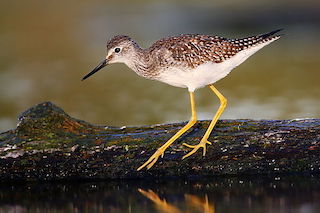 This distinctive bird is an occasional vagrant visitor to the UK in the autumn.
This distinctive bird is an occasional vagrant visitor to the UK in the autumn.
Photo: Wwcsig
Scientific name: Tringa flavipes
Conservation status: IUCN Red List, Least Concern
What to look for:
- Colouring and appearance: Slender wader with long yellow legs, long neck, straight dark-coloured bill, white undersides, upper parts brown/grey and streaked, grey rump.
- Size: Length 24 to 27 cm, wingspan 62 cm.
- Where: Breeds in North America, but is a fairly regular vagrant to Europe, including the UK (c. five records per year), between August and October.
- Similar species: Greater Yellowlegs, an even rarer visitor to our shores.
 If you see a Lesser Yellowlegs in the UK, then you are welcoming a creature from the other side of the Atlantic to our shores. This distinctive wader, with its eponymous long yellow legs and slender build, breeds in the bogs of the north of the American continent, between Alaska in the west and Hudson Bay in the east. It overwinters on the coasts of California, Virginia and the Gulf. However, vagrants do turn up in Europe and the UK: an average of five per year are recorded on our shores, most often between August and October when they are on migration. According to the BTO records (see link in references), one was recorded in Cornwall in 2004 and the Isles of Scilly in 2007, and now (in 2014) this individual has been spotted on the Lizard.
If you see a Lesser Yellowlegs in the UK, then you are welcoming a creature from the other side of the Atlantic to our shores. This distinctive wader, with its eponymous long yellow legs and slender build, breeds in the bogs of the north of the American continent, between Alaska in the west and Hudson Bay in the east. It overwinters on the coasts of California, Virginia and the Gulf. However, vagrants do turn up in Europe and the UK: an average of five per year are recorded on our shores, most often between August and October when they are on migration. According to the BTO records (see link in references), one was recorded in Cornwall in 2004 and the Isles of Scilly in 2007, and now (in 2014) this individual has been spotted on the Lizard.
In the Lesser Yellowlegs’ tundra breeding territories, the clutch of four eggs is laid in a depression under a small shrub or tree stump, close to water. Both parents care for the young, which can catch their own food very soon after hatching (ie. they are precocial) but the female often leaves before they have fledged, leaving the male to complete the task of defending the chicks until they learn to fly. The birds mainly eat invertebrates, both aquatic and terrestrial. They can often be spotted running, chasing prey through shallow water.
Once a game bird in America, it is now fully protected.
Did you know…?
…The species name flavipes is from the Latin for yellow foot.
…Both the Lesser and Greater Yellowlegs bob their heads up and down in the presence of an intruder to their territory.
More information and references:
Svensson, L., Mullarney, K., Zetterstrom, D.,1986. Collins Bird Guide, second edition (translated by Christie, D., Svensson, L.). HarperCollins, London.
Published: September 2014
Author: Amanda Scott
Photos: Wwcsig / CC BY-SA
